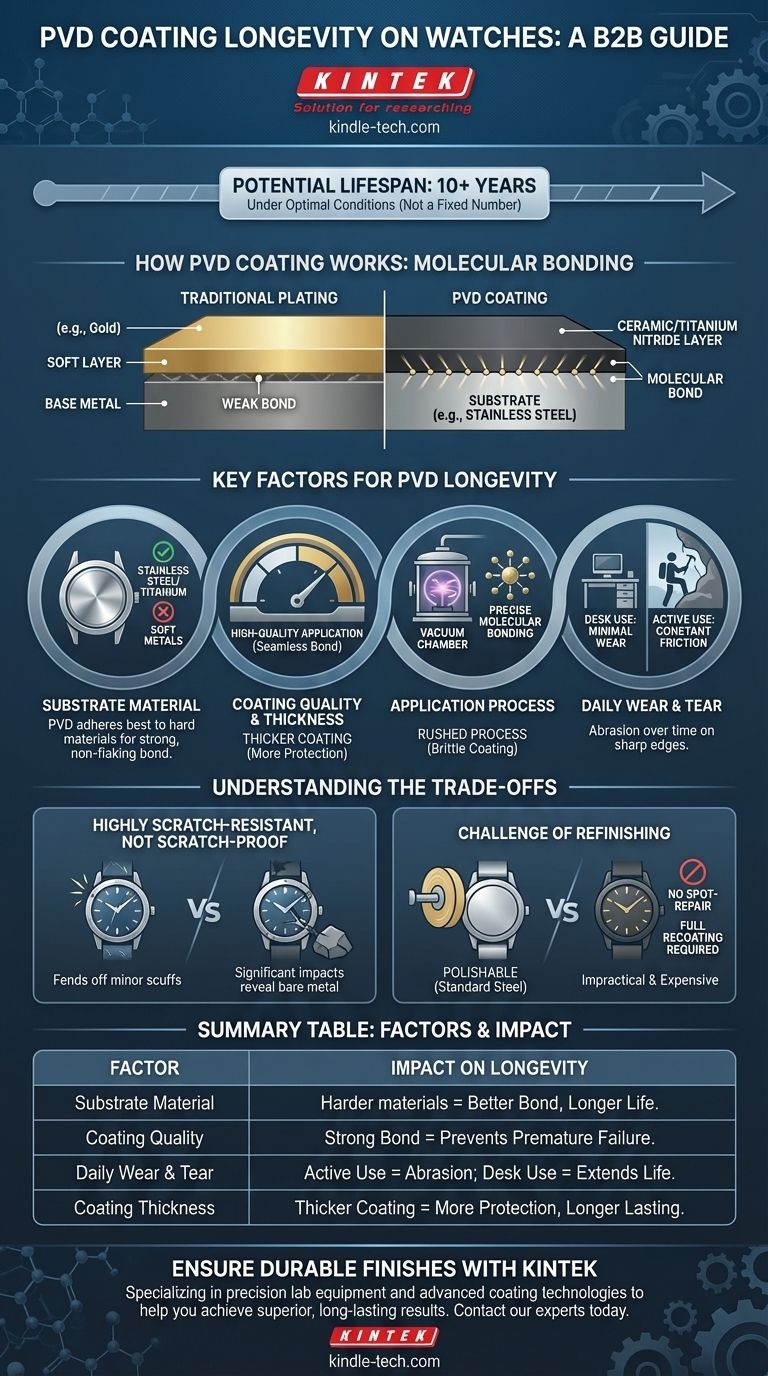Under the right conditions, a PVD coating on a watch can last for a decade or more. The longevity of this finish, however, is not a fixed number. It is a direct result of the quality of the application process, the materials used, and the daily life the watch endures.
The core takeaway is that PVD (Physical Vapor Deposition) is a highly durable surface treatment, not a simple layer of paint. Its lifespan depends less on a theoretical expiration date and more on the quality of the bond between the coating and the watch case, and its exposure to abrasive wear.

How PVD Coating Achieves Its Durability
To understand how long a PVD coating lasts, you must first understand what it is. It's a high-tech vacuum process, not a traditional plating or painting method.
The Molecular Bonding Process
In a vacuum chamber, a solid material (often a ceramic like titanium nitride) is vaporized into plasma. This vapor is then bonded to the watch's case and components at a molecular level, creating an extremely thin but hard and durable surface layer.
Why It's Superior to Plating
Traditional gold plating, for example, simply lays a soft layer of gold on top of the base metal. PVD, by contrast, creates a bonded finish that is part of the surface itself, making it far more resistant to daily wear, scratches, and corrosion.
Key Factors That Determine PVD Longevity
The vast difference in lifespan—from a few years to potentially a lifetime—is dictated by several critical factors.
The Substrate Material
The material of the watch case itself is the foundation. PVD adheres best to hard materials like surgical-grade stainless steel or titanium. A strong bond with a solid substrate ensures the coating won't easily flake or chip.
Coating Thickness and Composition
A thicker, well-applied coating will naturally offer more protection and last longer. The specific ceramic compound used for the coating also plays a major role in its hardness and scratch resistance.
The Quality of Application
The bond strength between the coating and the substrate is paramount. A high-quality application process ensures a seamless, powerful molecular bond. A rushed or poorly executed process will result in a brittle coating that fails prematurely, regardless of its thickness.
Exposure to Wear and Tear
This is the most significant real-world factor. A watch worn at a desk will show minimal wear for many years. A watch worn during manual labor or sports will be exposed to constant friction and impacts, which will inevitably abrade the coating over time, especially on sharp edges and corners.
Understanding the Trade-offs
While exceptionally durable, PVD coating is not indestructible. It's crucial to understand its limitations to set realistic expectations.
Scratch Resistance vs. Scratch-Proof
PVD coatings are highly scratch-resistant, meaning they can easily fend off minor scuffs and daily bumps. They are not, however, scratch-proof. A significant impact or a sharp drag against a harder material (like rock or concrete) can gouge through the coating to reveal the bare metal underneath.
The Challenge of Refinishing
This is the most critical trade-off. A standard stainless steel watch can have scratches polished out, making it look new again. A PVD coating cannot be spot-repaired or polished. Once a deep scratch exposes the underlying steel, the only way to fix it is to strip the entire case and have it professionally recoated, which is often impractical or prohibitively expensive.
Making the Right Choice for Your Watch
Your decision should be based on your lifestyle and aesthetic preferences.
- If your primary focus is a unique, lasting aesthetic: A PVD-coated watch from a reputable brand offers a durable finish that will resist fading and minor scratches for years of normal wear.
- If you lead a highly active or rugged lifestyle: Be prepared for the coating to show wear on high-contact areas like the bezel, lugs, and clasp over time.
- If you value the ability to repair cosmetic damage: A traditional, non-coated stainless steel watch that can be easily polished may be a more practical long-term choice.
Ultimately, a quality PVD finish provides a tough and visually striking alternative to bare metal, rewarding the owner who understands its inherent strengths and limitations.
Summary Table:
| Factor | Impact on PVD Coating Longevity |
|---|---|
| Substrate Material | Harder materials like stainless steel provide a better bond for longer life. |
| Coating Quality | High-quality application ensures a strong molecular bond, preventing premature failure. |
| Daily Wear & Tear | Active use leads to abrasion, while desk use minimizes wear, extending lifespan. |
| Coating Thickness | Thicker coatings offer more protection and can last significantly longer. |
Ensure your products feature the most durable finishes. KINTEK specializes in precision lab equipment and consumables, including advanced coating technologies. Our expertise helps you achieve superior, long-lasting results for demanding applications. Contact our experts today to discuss how we can support your laboratory's specific needs.
Visual Guide

Related Products
- RF PECVD System Radio Frequency Plasma-Enhanced Chemical Vapor Deposition RF PECVD
- Chemical Vapor Deposition CVD Equipment System Chamber Slide PECVD Tube Furnace with Liquid Gasifier PECVD Machine
- VHP Sterilization Equipment Hydrogen Peroxide H2O2 Space Sterilizer
- Split Chamber CVD Tube Furnace with Vacuum Station Chemical Vapor Deposition System Equipment Machine
- Molybdenum Tungsten Tantalum Special Shape Evaporation Boat
People Also Ask
- Why does PECVD commonly use RF power input? For Precise Low-Temperature Thin Film Deposition
- Why is PECVD environment friendly? Understanding the Eco-Friendly Benefits of Plasma-Enhanced Coating
- How are PECVD and CVD different? A Guide to Choosing the Right Thin-Film Deposition Process
- What is the principle of plasma enhanced chemical vapor deposition? Achieve Low-Temperature Thin Film Deposition
- What is plasma activated chemical vapour deposition method? A Low-Temperature Solution for Advanced Coatings



















